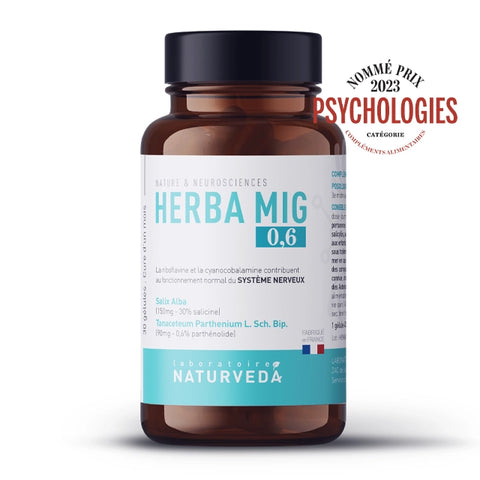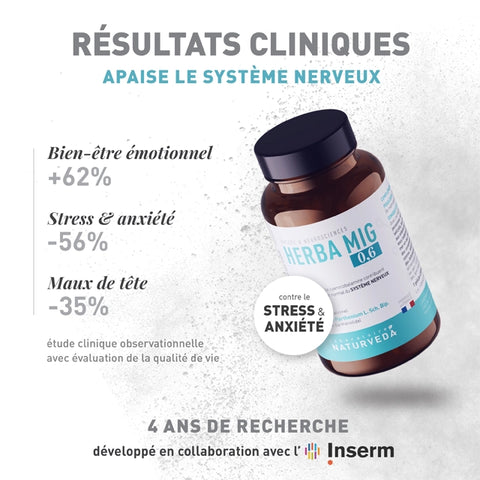7 products
Stress Post-Traumatique : Comment le Reconnaître et l'Apprivoiser
Les Origines du Stress Post-Traumatique : Causes et Facteurs Déclenchants
Le stress post-traumatique, aussi appelé trouble de stress post-traumatique (DSPT), est souvent généré suite à une expérience traumatisante. Ce traumatisme peut prendre plusieurs formes : une agression physique ou sexuelle, un accident grave, un événement naturel dévastateur, une guerre, ou même le décès soudain d'un proche. Parfois, ce stress peut également être provoqué par des situations de stress intense et prolongé, comme les mauvais traitements ou le harcèlement.
Il est important de noter que tous les individus n'auront pas de réponse de stress post-traumatique à un événement traumatique. D'ailleurs, deux personnes exposées au même traumatisme peuvent réagir différemment. Certaines personnes peuvent présenter des symptômes de stress immédiatement après l'événement, tandis que d'autres peuvent ne pas présenter de symptômes avant plusieurs semaines, voire plusieurs mois.
Une fois que le stress post-traumatique est déclenché, il peut se manifester de plusieurs façons. Les victimes peuvent revivre en boucle l'événement traumatique, à travers des cauchemars, des flashbacks, ou même des pensées intrusives durant la journée. Ces symptômes peuvent mener à l'insomnie et à l'évitement de situations qui pourraient rappeler l'événement traumatique. En outre, les personnes atteintes de stress post-traumatique peuvent également devenir irritable, se sentir en permanence sur le qui-vive, ou éprouver des sentiments de honte, de culpabilité, ou de tristesse.
Malgré ces défis, il existe des solutions pour apprendre à gérer le stress post-traumatique. La psychothérapie, y compris l'approche cognitivo-comportementale et l'exposition à la réalité virtuelle, peut être très effective. Par ailleurs, certains médicaments peuvent aider à atténuer les symptômes. Il est également crucial de prendre soin de sa santé physique, de sa nutrition et de pratiquer régulièrement une activité physique. Enfin, le soutien des proches et la participation à des groupes de soutien peuvent également être très bénéfiques.
Si vous, ou quelqu'un que vous connaissez, souffrez de stress post-traumatique, n'hésitez pas à chercher de l'aide. Vous n'êtes pas seul, et il existe des ressources pour vous aider à guérir et à reprendre le contrôle de votre vie.
Reconnaître les Signes : Symptômes du Stress Post-Traumatique
Après avoir abordé les origines du stress post-traumatique, il est crucial de savoir comment le reconnaître. Les symptômes peuvent varier considérablement d'une personne à une autre, mais généralement, ils s'articulent autour de trois catégories principales : le re-experimentation, l'évitement et l'hyper-arousal.
Le re-experimentation, comme son nom l'indique, consiste à revivre l'événement traumatisant. Cela peut se manifester par des flashbacks, des cauchemars, ou des pensées intrusives qui provoquent une détresse considérable.
L'évitement, quant à lui, s'exprime par le retrait de la vie sociale et l'évitement de toute situation qui pourrait rappeler le traumatisme. Les personnes vivant avec un stress post-traumatique peuvent également éprouver une perte d'intérêt pour des activités qu'elles appréciaient auparavant.
L'hyper-arousal est caractérisée par un état de tension constante. Cela peut entraîner des problèmes de concentration, des difficultés de sommeil, ou encore une irritabilité excessive.
Si vous ou un proche présentez ces symptômes, il est essentiel de consulter un professionnel de santé. De nombreuses méthodes permettent d'apprendre à gérer le stress post-traumatique, allant de thérapies cognitivo-comportementales à des médicaments afin de soulager la souffrance. Gardez à l'esprit que chaque personne est unique, et que ce qui fonctionne pour l'un peut ne pas fonctionner pour l'autre. Il est donc essentiel de chercher la meilleure solution adaptée à votre situation.
Impact du Stress Post-Traumatique sur la Vie Quotidienne
Le stress post-traumatique peut être un fardeau lourd à porter, et ses effets peuvent se propager bien au-delà de la personne qui en souffre pour toucher également sa vie quotidienne. Les tâches quotidiennes peuvent devenir un défi, avec des symptômes tels que l'irritabilité, la difficulté à se concentrer et l'insomnie qui entravent.
Imaginez-vous en train de faire vos courses ou de préparer le dîner tout en étant submergé par des sentiments de peur, de tristesse ou d'anxiété généralisée. Cela peut sembler insurmontable, n'est-ce pas? C'est une réalité pour ceux qui luttent contre le stress post-traumatique.
Il n'est pas rare que ces personnes aient également des difficultés dans leurs relations personnelles. Le trouble peut créer une barrière entre eux et leurs proches, car elles peuvent craindre d'être jugées ou incomprises. Cette coupure sociale peut encore aggraver les sentiments d'isolement et de détresse.
Stratégies et Solutions pour Gérer le Stress Post-Traumatique
Le bon côté est que le stress post-traumatique n'est pas une condamnation à perpétuité. Il existe des moyens de gérer et de réduire les symptômes afin de reprendre le contrôle de votre vie. La première étape est de reconnaître que vous luttez et de chercher du soutien. Cela pourrait signifier de parler à des amis ou à la famille, de rejoindre un groupe de soutien ou de chercher l'aide d'un professionnel.
De plus en plus, le traitement du stress post-traumatique combine un mélange d'interventions thérapeutiques, comme la thérapie cognitive comportementale (TCC), avec des stratégies d'autogestion, comme la pleine conscience. La TCC peut vous aider à comprendre et à changer les modèles de pensée qui vous rendent anxieux, tandis que la pleine conscience peut vous aider à gérer le stress et l'anxiété au quotidien.
Enfin, il est important de vous rappeler que chaque personne est différente - ce qui fonctionne pour une personne peut ne pas fonctionner pour une autre. Il est important que vous trouviez ce qui vous aide personnellement à gérer votre stress post-traumatique. La patience est essentielle, ainsi que la volonté d'accepter de l'aide et de faire l'effort d'aller de l'avant.
Thérapies Efficaces pour le Stress Post-Traumatique
Après avoir découvert les causes, les signes et l'impact du stress post-traumatique, parlons maintenant des moyens d'y faire face. Se battre contre ce type de stress peut sembler une tâche insurmontable, mais sachez que vous n'êtes pas seul. Diverses thérapies ont prouvé leur efficacité pour aider à gérer et même surmonter ce fardeau.
Un exemple remarquable est la thérapie cognitivo-comportementale (TCC). Elle vise à changer les schémas de pensée négatifs qui prolongent le stress post-traumatique. Vous apprendrez à identifier et à remettre en question ces pensées, et à adopter des attitudes plus saines et constructives. La TCC peut sembler difficile au début, mais sa réussite est souvent gratifiante et libératrice.
Une autre option couramment utilisée est la thérapie d'exposition. Cette méthode aide à réduire la peur et l'anxiété associées aux souvenirs traumatisants en vous exposant progressivement à l'objet de votre traumatisme dans un environnement sûr et contrôlé. Bien que cela puisse sembler effrayant, cette thérapie a montré d'excellents résultats dans de nombreux cas. Il est important de noter que cette thérapie doit toujours être conduite par un professionnel formé.
L'utilisation des médicaments peut également faire partie d'un plan de traitement pour le stress post-traumatique. Les médicaments ne sont pas une solution miracle, mais ils peuvent aider à gérer les symptômes tels que l’insomnie, les flashbacks, les crises d'angoisses et l’anxiété.
Quelle que soit la méthode que vous choisissiez, il est essentiel de travailler avec un professionnel de la santé mentale qui peut vous accompagner tout au long de votre parcours de guérison. Rappelez-vous, chaque pas, aussi petit soit-il, est un pas vers l'avant.
Le Rôle de l'Exercice et de la Nutrition dans la Gestion du Stress Post-Traumatique
Face à un trouble aussi complexe que le stress post-traumatique, chaque aspect de votre santé compte. Et vous avez déjà des outils puissants à votre disposition : l'exercice régulier et une bonne nutrition.
Il a été démontré que l'exercice physique régulier aide à réduire les symptômes d'anxiété et de dépression, qui sont souvent associés au stress post-traumatique. En outre, l'exercice peut vous aider à mieux gérer le stress en général. La raison en est simple : lorsqu'on fait de l'exercice, le corps libère des endorphines, surnommées les "hormones du bonheur", qui réduisent le stress chronique et améliorent l'humeur. Alors, que vous choisissiez de faire du yoga, de la course à pieds, de la natation ou de la musculation, l'important est de rester actif.
La nutrition joue aussi un rôle crucial dans la gestion du stress post-traumatique. Certaines études suggèrent en effet qu'une alimentation riche en vitamines B, en magnésium et en oméga-3, peut contribuer à réduire les symptômes de stress post-traumatique. Les aliments riches en ces nutriments comprennent les légumes à feuilles vertes, les fruits, les poissons gras, les noix et les graines. En évitant les aliments transformés et en privilégiant une alimentation riche en fruits, légumes et protéines maigres, vous pouvez donner à votre corps les nutriments essentiels pour combattre le stress, en particulier le stress de l'intestin.
Il est également intéressant de souligner les bienfaits des plantes en matière de gestion du stress post-traumatique. L'aubépine, le cassis et le figuier sont en effet connus pour leurs propriétés apaisantes.
L'aubépine, par exemple, favorise la relaxation en apaisant le système nerveux. Elle peut aider à réduire l'anxiété et favorise un sommeil réparateur, ce qui est souvent perturbé chez les personnes souffrant de stress post-traumatique. Le cassis, quant à lui, possède des propriétés anti-inflammatoires et aide à renforcer le système immunitaire, souvent affaibli par le stress chronique. Enfin, le figuier est reconnu pour ses effets bénéfiques sur le système digestif, régulant ainsi des troubles souvent associés au stress post-traumatique tels que la nausée ou les problèmes de digestion. Il agit aussi comme un calmant naturel, aidant à réduire les symptômes d'anxiété.
On ne peut parler de solutions naturelles pour combattre le stress post-traumatique sans mentionner les produits de Naturveda. Leur gamme comprend le macérat de cassis bio, une solution naturelle précieuse dans la lutte contre le stress mais aussi les inflammations. Il est également connu pour son pouvoir de drainage efficace, favorisant la bonne élimination des toxines de l'organisme.
Ensuite, il y a l'aubépine bio, un complément alimentaire qui soutient la circulation sanguine, favorise un sommeil de meilleure qualité et aide à gérer l'anxiété. De plus, leur macérat d’aubépine bio est une solution naturelle bénéfique pour le cœur et le système en général.
Et nous ne devons pas oublier le figuier macérât bio, une solution naturelle dédiée au système nerveux et à la digestion. Grâce à ses propriétés apaisantes, il est également efficace pour atténuer les effets du stress post-traumatique.
Ainsi, les produits de Naturveda peuvent être incorporés dans votre régime quotidien, formant une solution naturelle et complémentaire pour gérer efficacement le stress post-traumatique.
N'oubliez pas que malgré l'importance de l'exercice et de la nutrition, la gestion du stress post-traumatique nécessite souvent une approche combinée, qui peut inclure la thérapie et les médicaments. C'est pourquoi il est toujours recommandé de consulter un professionnel de la santé mentale.













